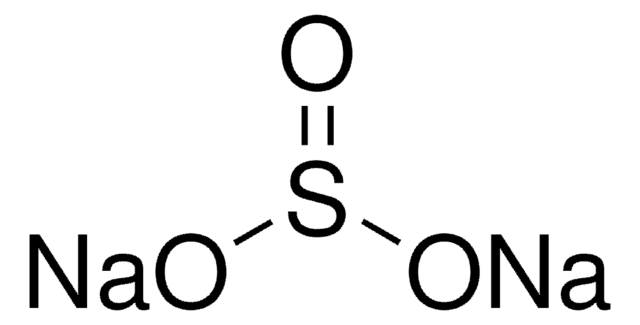Kluczowe dokumenty
13459
Sodium metabisulfite
puriss., meets analytical specification of Ph. Eur., BP, NF, FCC, E223, dry, 97-100.5%
Synonim(y):
Sodium disulfite, Sodium pyrosulfite
About This Item
Polecane produkty
klasa czystości
puriss.
Próba
97-100.5%
Formularz
powder or crystals
jakość
dry
meets analytical specification of Ph. Eur., BP, NF, FCC, E223
skład
SO2, 65.0-67.4%
zanieczyszczenia
residue of solvents, complies
≤0.02% thiosulfate (S2O3)
pH
3.5-5.0 (20 °C, 5%)
mp
>300 °C (lit.)
ślady anionów
chloride (Cl-): ≤100 mg/kg
ślady kationów
As: ≤2 mg/kg
Cu: ≤10 mg/kg
Fe: ≤10 mg/kg
Hg: ≤1 mg/kg
Pb: ≤2 mg/kg
Se: ≤5 mg/kg
Zn: ≤10 mg/kg
przydatność
complies for appearance of solution
ciąg SMILES
[Na+].[Na+].[O-]S(=O)S([O-])(=O)=O
InChI
1S/2Na.H2O5S2/c;;1-6(2)7(3,4)5/h;;(H,1,2)(H,3,4,5)/q2*+1;/p-2
Klucz InChI
HRZFUMHJMZEROT-UHFFFAOYSA-L
Szukasz podobnych produktów? Odwiedź Przewodnik dotyczący porównywania produktów
Powiązane kategorie
Opis ogólny
Zastosowanie
Hasło ostrzegawcze
Danger
Zwroty wskazujące rodzaj zagrożenia
Zwroty wskazujące środki ostrożności
Klasyfikacja zagrożeń
Acute Tox. 4 Oral - Eye Dam. 1
Zagrożenia dodatkowe
Kod klasy składowania
11 - Combustible Solids
Klasa zagrożenia wodnego (WGK)
WGK 1
Temperatura zapłonu (°F)
Not applicable
Temperatura zapłonu (°C)
Not applicable
Wybierz jedną z najnowszych wersji:
Masz już ten produkt?
Dokumenty związane z niedawno zakupionymi produktami zostały zamieszczone w Bibliotece dokumentów.
Klienci oglądali również te produkty
Nasz zespół naukowców ma doświadczenie we wszystkich obszarach badań, w tym w naukach przyrodniczych, materiałoznawstwie, syntezie chemicznej, chromatografii, analityce i wielu innych dziedzinach.
Skontaktuj się z zespołem ds. pomocy technicznej








